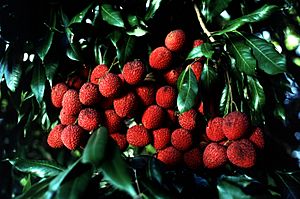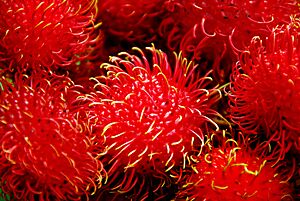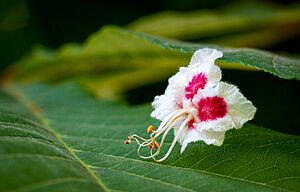Sapindaceae facts for kids
Quick facts for kids Soapberry family |
|
|---|---|
 |
|
| Litchi chinensis leaves and fruit | |
| Scientific classification | |
| Kingdom: | |
| Division: | |
| Class: | |
| Order: | |
| Family: |
Sapindaceae
|
| Genera | |
|
See text |
|
The Sapindaceae family, also known as the soapberry family, is a group of flowering plants. This big plant family includes many well-known trees and shrubs. You might recognize some of its members, like the maple tree, the horse chestnut, and tasty fruits like longan and lychee.
Scientists group plants into families based on their shared features. In a modern system called APG II (from 2003), the Sapindaceae family also includes plants that used to be in separate families, like the maples (Aceraceae) and horse chestnuts (Hippocastanaceae). All these plants are part of a larger group called the Sapindales order.
Contents
What is the Soapberry Family?
The name "soapberry" comes from some plants in this family. Their fruits contain a natural substance called saponin. When mixed with water, saponin creates a soapy foam. People have used these "soapberries" for washing clothes and hair for a long time.
This family is very diverse, meaning it has many different kinds of plants. They can be trees, shrubs, or even vines. They grow in many parts of the world, especially in tropical and subtropical areas.
Where Do They Grow?
Plants from the soapberry family can be found all over the globe. They are common in tropical and subtropical regions. This includes places like Asia, Africa, and the Americas. Some members, like maple trees, also thrive in cooler, temperate climates.
You might see them in forests, gardens, or even growing wild. Their ability to adapt helps them live in many different environments. This wide distribution shows how successful this plant family is.
What Makes Them Special?
Plants in the Sapindaceae family share some common features. However, they also have many differences. These differences help them survive in various places.
Leaves and Branches
Most plants in this family have leaves that grow in a special way. They are usually arranged in a spiral pattern along the stem. The leaves can be simple, meaning they are just one blade. Or, they can be compound, made up of several smaller leaflets.
Maple trees, for example, have simple leaves with distinct lobes. Horse chestnuts have large, palm-shaped compound leaves. Many soapberry plants also have small, often green or brown, branches.
Flowers and Fruits
The flowers of Sapindaceae plants are usually small. They often grow in clusters. These flowers can have both male and female parts, or they might be separate male and female flowers on the same plant. Bees and other insects often visit these flowers. They help the plants make seeds.
The fruits of this family are very varied. They can be fleshy, like the lychee and rambutan. They can also be dry, like the winged seeds of maple trees. These different fruit types help the seeds spread in many ways.
Famous Family Members
The Sapindaceae family includes many plants that are important to people. Some provide food, while others are used for wood or as ornamental plants.
Maple Trees
Maple trees are famous for their beautiful leaves. These leaves turn bright colors in autumn. Maple syrup, a sweet treat, comes from the sap of certain maple trees. Maple wood is also very strong. It is used to make furniture, floors, and musical instruments. Maples are common in North America and Asia.
Delicious Fruits: Lychee, Longan, and Rambutan
Lychee, longan, and rambutan are popular tropical fruits. They all have a sweet, juicy flesh around a single seed. Lychees have a bumpy red skin. Longans have a smooth, light brown skin. Rambutans are covered in soft, hairy spines. These fruits are enjoyed fresh or used in desserts and drinks. They are mainly grown in Asia.
Horse Chestnuts
Horse chestnuts are large, beautiful trees. They are often planted in parks and along streets. Their large, spiky fruits contain shiny brown seeds. These seeds are sometimes called "conkers." While they look like edible chestnuts, horse chestnuts are not safe for humans to eat. They contain substances that can be harmful.
How Do They Reproduce?
Like all flowering plants, members of the Sapindaceae family reproduce using seeds. Their flowers play a key role in this process. Most species rely on insects, like bees, to carry pollen from one flower to another. This is called pollination.
After pollination, the flowers develop into fruits. These fruits protect the seeds as they grow. Once the fruits are ripe, they help spread the seeds. Some fruits are eaten by animals, which then spread the seeds in their droppings. Others, like maple seeds, have "wings" that help them spin and float away in the wind. This helps new plants grow in different places.
Images for kids
-
Dodonaea viscosa flowers
See also
 In Spanish: Sapindáceas para niños
In Spanish: Sapindáceas para niños





